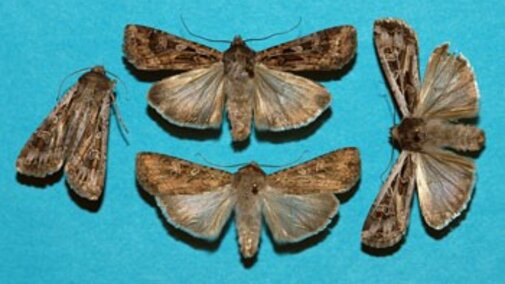The moths of army cutworms are being found in several University of Nebraska-Lincoln traps (Table 1). These “miller moths” are the adult stage of cutworms that were commonly found this spring in Nebraska wheat and alfalfa fields. The moths are generally gray or light brown (Figure 1), with a wingspan of 1 1/2 to 2 inches. Each forewing is marked with spots, wavy lines, and other dark and light markings.
| Total moths collected each week | |||
|---|---|---|---|
| Location | April 29-May 5 | May 6-12 | May 13-20 |
| Clay Center, NE | 4 | 1 | 78 |
| North Platte, NE | 5 | 0 | 18 |

Spring emerging army cutworm moths migrate from east to west to eventually spend the summer months in mountainous areas of Colorado and Wyoming. The migrating moths feed in the evening on nectar from flowering plants such as lilacs, viburnums, and linden trees. They do not cause any damage to the plants as they feed. During the daylight hours the moths seek shelter in cracks and crevices including those found in houses and other buildings. The moths begin to emerge from these locations at dusk to resume their feeding and westward migration.
The moths are very attracted to light and may be noticed circling porch lights where they can easily move into living spaces. Moths inside structures can cause human anxiety from their persistent movement around lighting. While they do not cause other harm, they can leave droppings resulting in small stains on surfaces. The stains are readily removed with a mixture of water and most types of common cleaning solutions.
Management
The best management method is to keep the moths from entering structures. Keeping porch lights off or the use of yellow colored light bulbs will reduce the number of moths that might enter through a door. The moth’s attraction to light can be used as a method to remove those that have entered a building. A simple trap can be constructed with a goose neck lamp placed over a small bucket that contains soapy water. The moths that fly around the trap will soon be caught in the water where they will drown. The dead moths can then be dumped outside. Application of insecticides are not recommended to control adult moths.
Migratory Behavior
The great hoards of millers in the spring are a result of their migratory nature. Their numbers depend on spring cutworm populations and environmental conditions. Moths emerging in Nebraska tend to remain in the area for two to three weeks, but may stay for up to six weeks or as long as local plants are flowering. Cool, wet conditions during this time will extend their stay. Hot, dry conditions will encourage them to move westward.
The moths will migrate westward to higher elevations as they follow the progression in the initiation of spring flowering plants. During this time, with the aid of easterly winds, moth concentrations can increase dramatically. When the last trees finish flowering (e.g. locusts and lindens) and temperatures increase in the high plains, the moths move to the Rocky Mountains. There they escape severe summer temperatures and find alpine flowers, their primary food source. Interestingly, the moths can serve as a high-energy food for grizzly bears foraging in high alpine areas.
In September, the moths once again return to the plains. Army cutworm moths are noticed throughout Nebraska from mid-September through October. As they migrate eastward in the fall, they mate and lay eggs in barren or sparsely vegetated fields, especially winter wheat, alfalfa and grasslands. The eggs hatch within a few weeks and the larvae begin to feed. The cutworms enter a diapause state during the winter and resume feeding in the spring.

